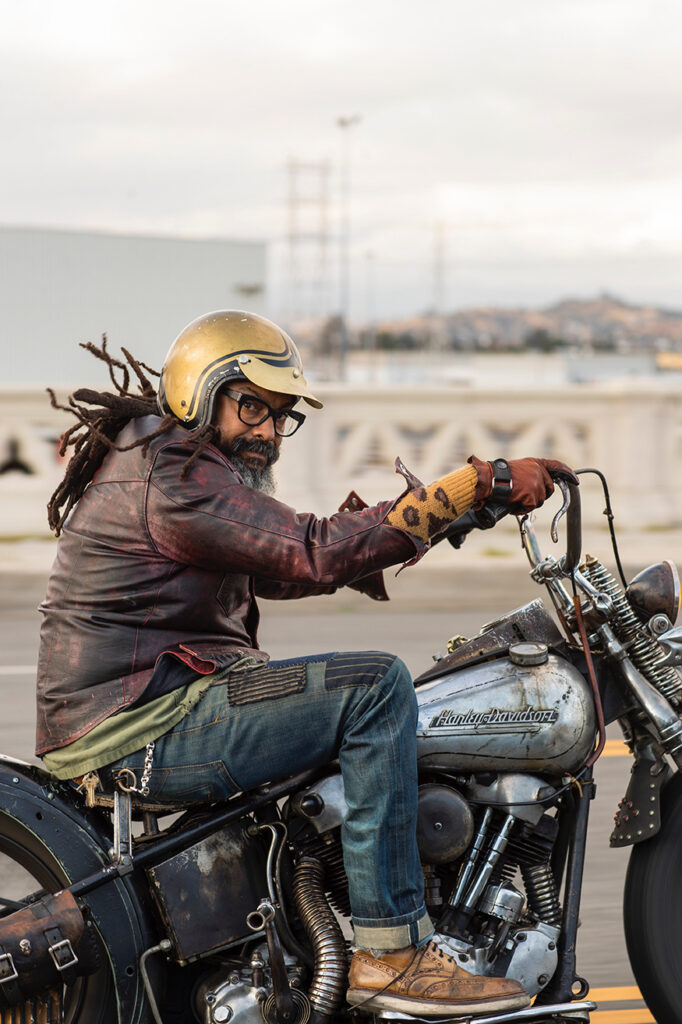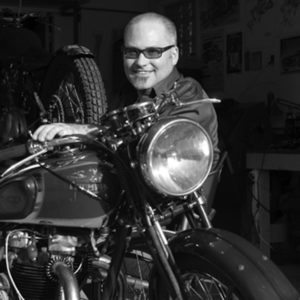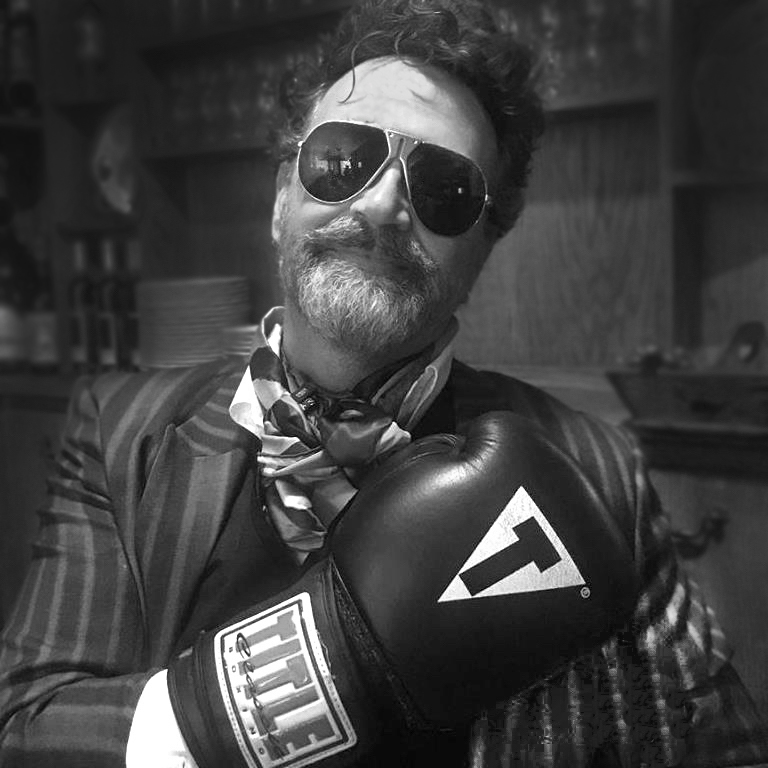Every picture tells a story. *
We have all, at some impressionable moment, been moved by a photograph. And sometimes, the energy in the image misaligns with our own so perfectly it changes every molecule in our being. Our expression of that impact might be as simple as a wardrobe change and new music on our playlist, or as profound as a wholly new direction in life. For Wil Thomas, the discovery of a late 1940s image of two Black men on distinctive motorcycles was the inspiration for both study and creation: a close observation of what is shown and implied in that photo, the history suggested, the mood and lifestyle of those riders, their choice of machines. Eventually, the photo inspired a replica of the Harley-Davidson Knucklehead bob-job under one of the riders – the one with the ‘thousand-yard stare’.




Cresting the gravel drive filled with weeds and ruts, a weatherworn wooden shed with a grimy window appears at the end of the road. A heavy door locked with a rusty padlock yields easily to a pair of bolt cutters. Creaking open on rusty hinges, dim sunlight shines through dust motes to reveal a piece of greasy old chrome. It’s a motorcycle, and not just any machine, but a custom 1947 Harley-Davidson stashed away by its builder, Wil Thomas.
None of the above is true, apart from Wil having built the Knucklehead. Rather, the Los Angeles-based creator says it’s a romantic vision; a possible scenario of what he’d like to see happen to the machine he built. “We all dream about finding an old motorcycle or parts in a shed,” Wil tells me. “That’s romantic, and that’s cool, and that feels real. The bike was here long before me, and it will be here long after I’m gone. Maybe someone with a grander vision will blow it apart and make it better, or maybe someone will think it special enough to preserve it. Somewhere in the middle of that is the truth, but for just this period of its history I’m its custodian.”

During summers, Wil worked on a horse ranch near Potosi, Missouri, a community 72 miles south of his hometown of St. Louis. For $10 a day, he labored in the barns and looked after tack and equipment. “There’s a culture around horsemanship – and the motorcycle is similar. There’s a command of the horse, and there’s a command of the motorcycle; it’s a perfect analogy.”

After high school, Wil played university-level soccer for a couple of years, but gave up athletics and school when he enlisted in the United States Marines. Aboard the USS Ogden, he saw active duty for four years, and inactive duty for another four. Initially, he was stationed in California and was involved in the first Gulf conflict during 1990 and 1991. “When you’re sitting on a ship, during down time or while cleaning weapons you tend to dream off of the real world and we were always talking about one of three things; food, chicks or motorcycles,” Wil explains. “I was walking around in a Harley-Davidson T-shirt, but felt I was living a lie and said I would never wear another motorcycle shirt until I got a bike.

Although the girl didn’t last, Wil says he kept and rode the Kawasaki for quite a few years. And, because he didn’t know all that much about motorcycles, he took a part time job working weekends on the parts counter at Illinois Harley-Davidson in Countryside. That’s when he invested in a Big Dog chopper – a bike he says didn’t end up meaning much to him. “I got a Sportster shortly after that, and once I started tinkering with and modifying the Sportster I never rode the Big Dog again. When I started working on my own bike, and modifying it to my aesthetics, that’s when it really started to evolve for me.”

“He told me if I liked the bikes, I had to go to the Flatiron Building at Six Corners (a well-known convergence of three streets in Chicago) and go in the basement,” Wil recalls. “He said there were two guys there who built them. So, one day I found myself on that corner and I walked on down there. I talked to a guy about learning a bit more about the bikes, and he just said, ‘Bring beer.’” Wil spent $44 a week on Bud Light and, while listening to live traditional roots and blues music, learned even more about motorcycles and the custom-building community. Shortly after, he spotted an ad in the Chicago Tribune newspaper.

“Over that winter, I put my aesthetic on the Panhead, and I drew heavily from images of a green Panhead on the cover and in the pages of DicE Magazine’s issue No. 4,” he says. “It had Z-bars, and I modified mine with a set of those, a Frisco Sporty tank and a Wassell fender. My Panhead granted me entrance to the lifestyle and the people, and I was invited to shows and runs, including my first El Diablo Run in 2006.”

Wil chuckles, “From that day on, if someone had a big beard or looked like they knew something about Knuckleheads, my mom would go up to them and ask if they knew of one for sale. She focused her energy on that search.”
And, wouldn’t you know it, Mom came through. Once after visiting Wil, while flying home, she had a copy of a motorcycle magazine in her hands. Sitting next to her was a fellow who asked if she was into motorcycles. Not personally, but she had a son who was, and say, you wouldn’t know anyone with a Knucklehead for sale? “This guy knew a guy who did, though, and I got a contact number,” Wil says. “I called him, and talked to him for a bit. He wasn’t looking to sell it then, but about a year later he phoned me up and said he was moving on, and offered me the Knuck.”

“I have that photograph framed and on the wall in my garage and in my office,” Wil says. “I walk past them every day, and there are not a ton of images of brothers on bikes. I’d always trip off the brother on the Knuck, and wonder about the story. It looks like its 1947 or 1948, and I wonder if they’d just got back from the War and said, let’s buy bikes and ride to New Orleans. I’m making up the story, but they look like military men to me. The guy on the Knuck, he’s so intense, and in his eyes, he looks like he’s seen beyond.”

He started with the frame, getting help to return it as close as possible to stock dimensions. With those repairs completed, he mounted a set of stock gas tanks, a chromed springer fork with Stelling & Helling risers and bars and an abbreviated rear fender. All of the parts were well-used pieces he’d picked up over the years at various meets – none of the bits came from sources such as eBay. The exhaust set up, Wil says, was not his favorite part until he put it on the Knuck to cut it up. “I went from hating it to liking it, and sometimes the piece you don’t like is the thing that ends up making the bike,” he says of the exhaust, and adds, “I let the bike tell me exactly what it wants to be.”

Wil emphasize that he’s still no mechanic. He relies on others with specialized skills to ensure a motor or transmission is built and set up correctly. When it comes to building a bike, however, Wil’s specialty is his innate sense of line and what looks ‘right’ and his ability to fit the pieces together. Since finishing the ’47 Knuck, it’s essentially not been changed, and the machine truly has an identity of its own. After spending years living in an L.A. loft where he can pull into the garage, load a bike into the freight elevator and bring it up to his living room (he currently has eight bikes up there), Wil is contemplating a change.
“It looks like something out of a dream, but there’s a heavy dose of reality that goes along with living where I do,” Wil says. “It’s a very cool chapter of my life, but I always said I was going to go back to the country and horses. If I do, I’d like to put that Knuck away in a shed, perhaps leaving it there for someone else to find long after I’m gone. Now, that feels real.”
*from Rod Stewart’s seminal 1971 song and album of the same name.



Related Posts
July 25, 2017
The Vintagent Trailers: Morbidelli – a Story of Men and Fast Motorcycles
Discover the story of the Morbidelli…




What a truly great tale! Always below the surface of such stories, flow the currents of life itself, carrying the tiny particles of moments that compose a human being’s experience if this world. That’s the only way a dream can feel so real that it comes true. Thank you for bringing this online, I only hope it sees print in the future, may it be on paper or film. Cheers!
Raul, we hope to put this on a short film in the near future!
Great story and photos, my friend Wil ( Chicago Wil ) is truly a Renaissance man. With so much class and style. I’m proud to say he’s my friend and one of the producers of our documentary Sugar and Spade. Thank you for your friendship and what you do for the chopper Community in general.
Thanks for this. I’m grateful to have read it.
Two huge thumbs up for both stories and the photos ! The Vintagent at its finest !
The man in the photo ? Looks to me like on seriously PO’d man who’s realized all the sacrifices he’d made during the war hadn’t made a damn bit of difference to his or his family’s lives once he returned home .
Truly … god d____ this broken promise land !
And there’s that…or all of the above. Lucius has a cheery disposition, but his friend’s badass demeanor looks well earned, somehow.
I get what you’re thinking . And …. you may be right . But after near on 60 years of performing , touring , studying with , protesting along side of with many African American men etc , et al …
My bet is …. Mr Dawkins was hoping the truths of the US Constitution and Bill of Rights would apply in full after all they contributed to victory … whereas … his bobber riding compadre … has comes to grips with the very harsh reality to come . Wish more could be found out about the bobber riding gentleman ,.
Here’s hoping for the film !
PS ; Believe it or not I spent a good four hours trying to find anything on Mr Dawkins … including the VOC archives , my Vincent book collection etc … and
Nada … nothing … nary a word
Sigh …, the history some chose to ignore .
Finally … to end on a positive … once again … another round of kudos for another excellent collaborative article and photos . Yours IS the only M/C site paying attention !
Independence has its benefits!
That guy doesn’t have a Thousand Yard Stare, he is just grumpy because he has to ride an overweight, slow Harley, not a 110 mph thoroughbred like his buddy’s Vincent Rapide.
Yeah, but his Knuck is truly badass and an iconic American custom. Granted, a Vincent single would blow it off, but that’s probably not the point for him…